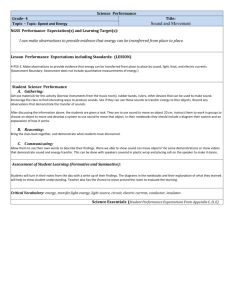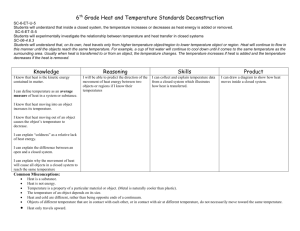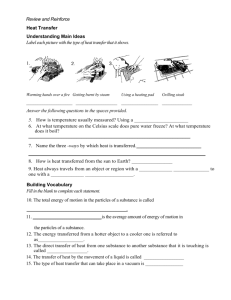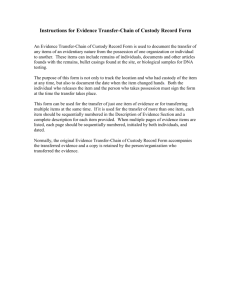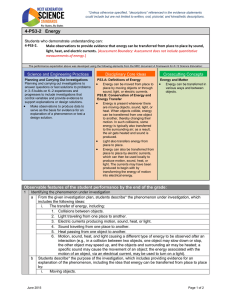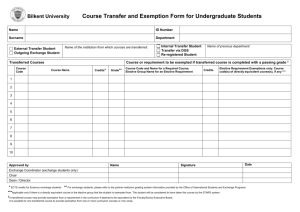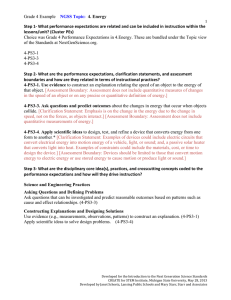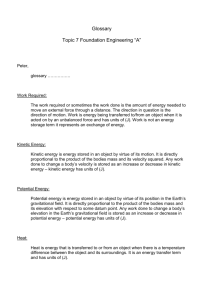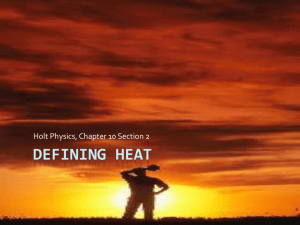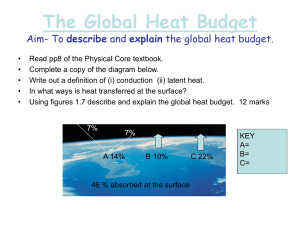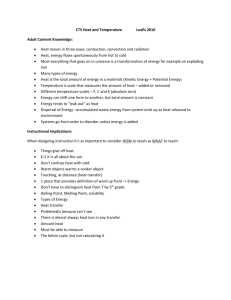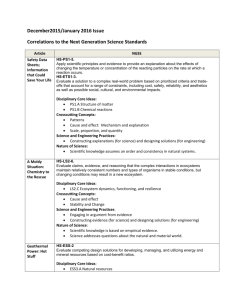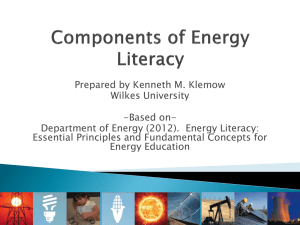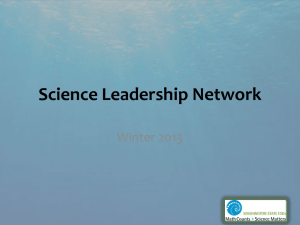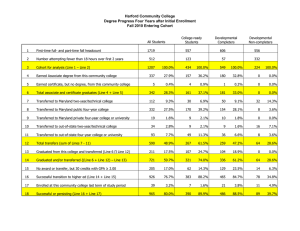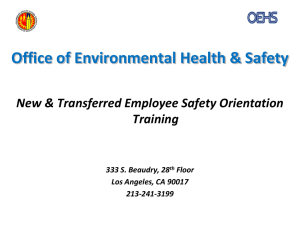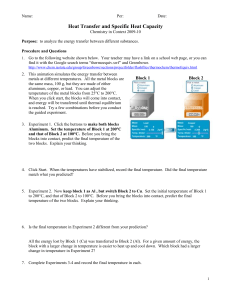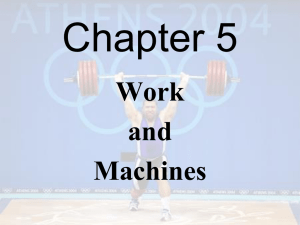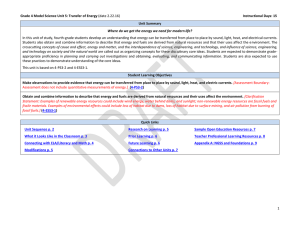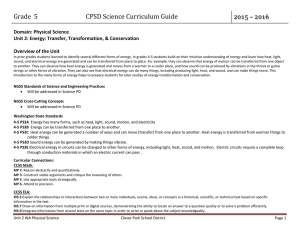Introductory Materials - Center for Learning in Action
advertisement
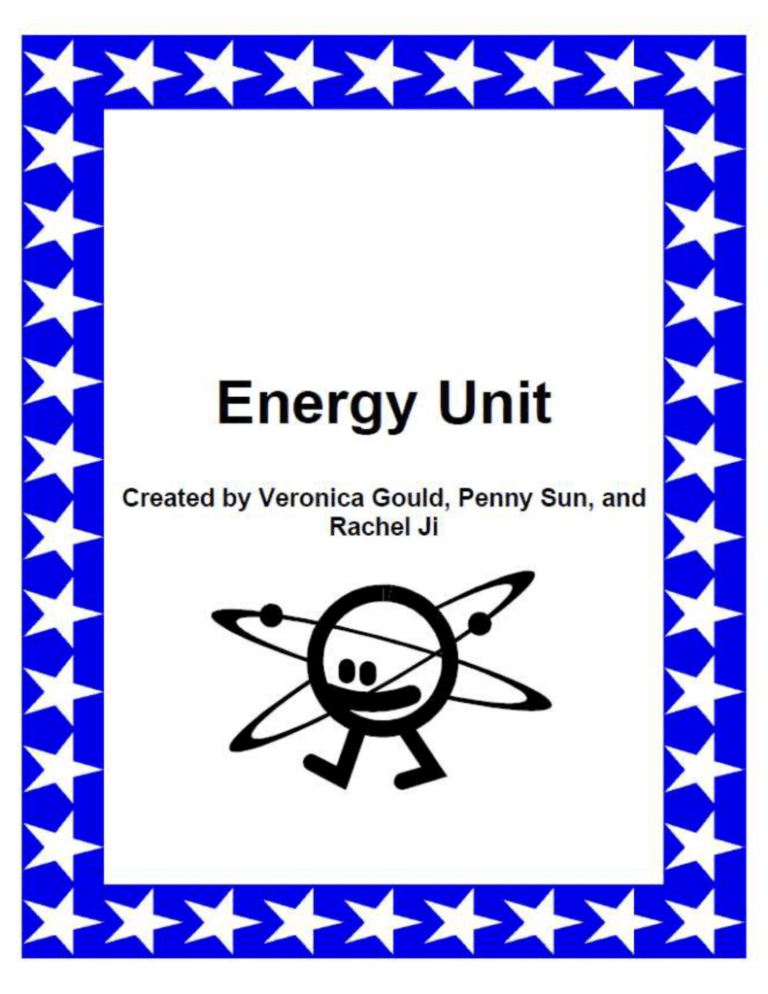
Energy Unit Big Questions: What is energy? How is energy transferred from place to place? How is energy converted from one type to another? How do humans harness energy for everyday use? Massachusetts Science and Technology Learning Standards Physical Science Disciplinary Core Ideas 1) The faster a given object is moving, the more energy it possess. 2) Use evidence to construct an explanation relating the speed of an object to the energy of that object. 3) Ask questions and predict outcomes about the changes in energy that occur when objects collide. 4) When objects collide, the contact forces transfer energy so as to change the objects’ motions 5) Energy is present whenever there are moving objects, sound, light, or heat. 6) Make observations to provide evidence that energy can be transferred from place to place by sound, light, heat, and electric currents. 7) The expression “produce energy” typically refers to the conversion of stored energy into a desired form for practical use. 8) When objects collide, some energy is typically also transferred to the surrounding air; as a result, the air gets heated and sound is produced. 9) Light also transfers energy from place to place. 10) Energy can also be transferred from place to place by electric currents, which can then be used locally to produce motion, sound, heat, or light. The currents may have been produced to begin with by transforming the energy of motion into electrical energy. Science and Engineering Practices 1) Use evidence (e.g., measurements, observations, patterns) to construct an explanation. 2) Make observations to produce data to serve as the basis for evidence for an explanation of a phenomenon or test a design solution. 3) Ask questions that can be investigated and predict reasonable outcomes based on patterns such as cause and effect relationships. 4) Apply scientific ideas to design, test, and refine a device that converts energy from one form to another. 5) Apply scientific ideas to solve design problems. 6) Possible solutions to a problem are limited by available materials and resources (constraints). The success of a designed solution is determined by considering the desired features of a solution (criteria). Different proposals for solutions can be compared on the basis of how well each one meets the specified criteria for success or how well each takes the constraints into account. Crosscutting Concepts 1) Science affects daily life. 2) Most scientists and engineers work in teams. 3) Energy can be transferred in various ways and between objects. Technology/Engineering Disciplinary Core Ideas 1) Tests are often designed to identify failure points or difficulties, which suggest the elements of the design that need to be improved. 2) At whatever stage, communicating with peers about proposed solutions is an important part of the design design process, and shared ideas can lead to improved designs. 3) Define a simple design problem reflecting a need or a want that includes specified criteria for success and constraints on materials, time, or cost. 4) Generate and compare multiple possible solutions to a problem based on how well each is likely to meet the criteria and constraints of the design problem. 5) Plan and carry out fair tests in which variables are controlled and failure points are considered to identify aspects of a model or prototype that can be improved. 6) Research on a problem should be carried out before beginning to design a solution. 7) At whatever stage, communicating with peers about proposed solutions is an important part of the design process, and shared ideas can lead to improved designs. 8) Different solutions need to be tested in order to determine which of them best solves the problem, given the criteria and the constraints. Science and Engineering Practices 1) Plan and conduct an investigation collaboratively to produce data to serve as the basis for evidence, using fair tests in which variables are controlled and the number of trials considered. 2) Define a simple design problem that can be solved through the development of an object, tool, process, or system and includes several criteria for success and constraints on materials, time, or cost. 3) Generate and compare multiple solutions to a problem based on how well they meet the criteria and constraints of the design problem. Crosscutting Concepts 1) People’s needs and wants change over time, as do their demands for new and improved technologies. 2) Engineers improve existing technologies or develop new ones to increase their benefits, decrease known risks, and meet societal demands. General Teaching Tips PLEASE READ! Make sure to develop a good working relationship with your classroom teacher. Communication is vital. Plan when you will meet to discuss the next lesson and how you will let each other know about schedule conflicts. Read the lessons well ahead of time (at least about 1 week before) so that you are prepared when you get to the classroom. Some lessons require additional materials or videos or apps (4th grade only) so you will need to make sure you are aware of these additional items in time to make arrangements or familiarize yourself in advance. Your feedback is very valuable to your fellow teachers in different classes and future teachers or curriculum writers. These lessons are living documents subject to change and your input is valued. Please keep your comments on GLOW up to date with your lessons. Asking good questions and getting students to ask good questions or make connections from different units of study or previous lessons is one of the most important parts of science education. Ask your students meaningful questions about the science activities they are doing. Encourage curiosity by giving your students the opportunity to ask their own questions. If you don’t know the answer, work together to find more information. Review questions or questions meant to have students restate the important ideas of the lessons are very valuable. Students should be encouraged to vocalize their thoughts and questions whenever possible. The lessons should act as guides. Your teaching experience will be more successful if you incorporate your own style to the lessons. Within the conceptual framework provided, make changes as you and your classroom teacher see fit. That being said, each of these lessons was carefully created to fulfill state education requirements. So while the format of the activities may be flexible and additional activities can be valuable, the activities in each lesson are necessary to cover minimum curriculum requirements. If you choose to use other interactive or visual explanations to support the basic concepts of the lessons that you teach, apply these ideas as you see fit, and please share your ideas on the GLOW thread for that lesson. Each lesson includes an estimated time frame. Some classes may go slower and some may go faster. As you get to know your class, pace the lessons accordingly. This may involve cutting, restructuring, or adding certain activities. Alternatively, some lessons may span 2-3 days instead of only 1 day. Written student work is often used to teach students good habits about following steps of the scientific method. The worksheets provided are meant to teach students what sort of information is relevant. Some students may finish written work and some may not. It is more important to focus on the main concepts of the lesson.
